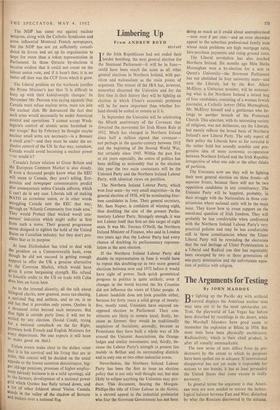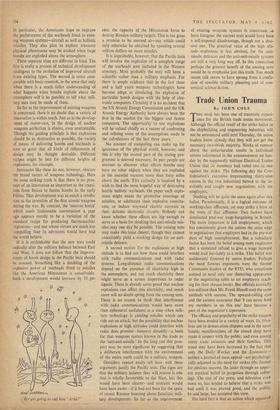The Arguments for Testing
By JOHN MADDOX
BY lighting up the Pacific sky with artificial auroral displays the American nuclear tests may turn out to be the most spectacular yet. True, the playworld of Las Vegas has before been disturbed by rumblings in the desert, while the Marshall Islanders have good cause to remember the explosion at Bikini in 1954. But most tests have been physically unobtrusive. Radioactivity, which is their chief product, is after all visually unremarkable.
The new series of tests differs from its pre- decessors by the extent to which its purposes have been spelled out in advance. If international disapproval has not yet made it impossible for nations to test bombs, it has at least persuaded the United States that some excuse is really necessary.
In general terms' the argument is that Ameri- can tests are now needed to restore the techno- logical balance between East and West, disturbed by what the Russians discovered in the autumn. In particular, the Americans hope to improve the performance of the warheads fitted to exist- ing weapons systems—aircraft as well as ballistic missiles. They also plan to explore whatever physical phenomena may be evoked when large bombs are exploded above the atmosphere.
These separate aims are different in kind. The first is really a process of technical development analogous to the evolution of improved aircraft from existing types. The second is more com- parable with basic research, in the sense that only when there is a much fuller understanding of what happens when bombs explode above the atmosphere will it be possible to tell what mili- tary uses may be made of them.
So far as the improvement of existing weapons is concerned, there is no doubt that a variety of innovation is within reach. Just as in the develop- ment of motor-cars, in the design of nuclear weapons perfection is elusive, even unattainable. Though the guiding principle is that explosions should be as destructive as possible, the variety of means of delivering bombs and warheads is now so great that all kinds of refinements of design may be thought desirable. Different recipes might be best for different heights of explosions, for example.
Intricacies like these do not, however, obscure the broad nature of weapons technology. Here the most striking truth is that there is no pros- pect of an innovation as important as the transi- tion from fission to fusion bombs in the early Fifties. That development was as much a revolu- tion as the invention of the first atomic weapons during the war. By contrast, the 'neutron bomb' which made fashionable conversation a year ago appears merely to be a variation of the standard recipe for producing thermonuclear explosions—and one whose virtues are much less compelling than its advocates would have had the world believe.
If it is unthinkable that the new tests could radically alter the military balance between East and West, it does not follow that the improve- ments of bomb design in the Pacific tests should be scorned. Something like a doubling of the explosive power of warheads fitted to missiles like the American Minuteman is conceivable. Such a development would increase by 35 per lie are going to call hint "Ariel."' cent. the capacity of the Minuteman force to destroy Russian military targets. This is too great a promise to be sneezed at—one which could only otherwise be obtained by spending several million dollars on more missiles.
It is improbable, however, that the Pacific tests will involve the explosion of a complete range of the warheads now included in the Western armoury. Most probably the tests will have a scientific rather than a military emphasis. For there is ample evidence that in the last three and a half years weapons technologists have become adept at simulating the explosion of particular bomb designs with the help of elec- tronic computers. Certainly it is no accident that the US Atomic Energy Commission and the UK Atomic Energy Authority have always been the first in the market for the biggest and fastest computers. The opportunity to test explosions will be valued chiefly as a means of confirming and refining some of the assumptions made in the calculations of the last three years.
No amount of computing can make up for ignorance of the physical world, however, and this is why the second part of the testing pro- gramme is deemed necessary. In part people are anxious to discover what effects bombs may have on other objects when they are exploded in the essential vacuum more than forty miles above the earth. This curiosity is inspired by a wish to find the most hopeful way of destroying hostile ballistic warheads. On paper such explo- sions might erode the protective coverings of missiles, or adulterate their explosive constitu- ents, or induce wayward electric currents in their delicate electronic circuits. Nobody can know whether these effects are big enough to serve as a basis for thinking that anti-missile mis- siles may one day be possible. The coming tests may make this issue clearer, though they cannot conceivably yield a working design for an anti- missile defence.
A second motive for the explosions at high altitude is to find out how these could interfere with radio communications and with radar systems. Long-distance radio communications depend on the presence of electricity high in the atmosphere, and too much electricity there might serve as a screen impervious to radar signals. There is already some proof that nuclear explosions can affect this electricity, and much more will no doubt spring from the coming tests. There is no reason to think that interference with radio communications would have more than ephemeral usefulness at a time when mili- tary technology is yielding missiles which can ride out an attack, but the possibility that nuclear explosions at high altitudes could interfere with radar does promise—however distantly—a basis for that weapons system known in the trade as the 'anti-anti-missile.' In the long run this pros- pect may be most significant by suggesting that a deliberate interference with the environment of the entire earth could be a military weapon. Outsiders cannot easily tell how well these arguments justify the Pacific tests. The signs are that the military balance they will restore is one that is wholly favourable to the West, but this would have been clearer—and restraint would have been easier—if it had not been for the spate of recent Russian boasting about futuristic mili- tary developments. So far as the improvement of existing weapons systems is concerned, i.o have foregone the current tests would have been a self-imposed disadvantage, though not a deci- sive one. The practical value of the high alti- tude explosions is less obvious, for the anti- missile defences and the anti-anti-missile systems are still a very long way off. In this connection perhaps the greatest benefit of the coming tests would be to emphasise just this truth. Too much recent talk seems to have sprung from a confu- sion of sensible military planning and of non- sensical science-fiction.







































 Previous page
Previous page